Limited to 500 copies. Can be purchased direct from the label.
No CommentsDesultory – Counting Our Scars
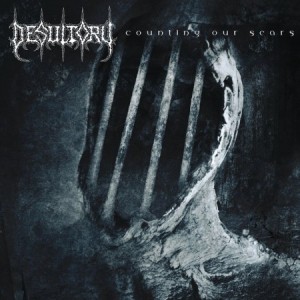 The term “melodic death metal” has lost all meaning with the rise of its postmodern form, which is essentially heavy metal or power metal (speed metal + later heavy metal) with death vocals, played at twice normal speed and using tuning and mode to achieve a melodic sound. The genre often fails because in an effort to deliver lots of those sweet ripping melodic moments, it renders itself uniform and thus passes like sonic wallpaper.
The term “melodic death metal” has lost all meaning with the rise of its postmodern form, which is essentially heavy metal or power metal (speed metal + later heavy metal) with death vocals, played at twice normal speed and using tuning and mode to achieve a melodic sound. The genre often fails because in an effort to deliver lots of those sweet ripping melodic moments, it renders itself uniform and thus passes like sonic wallpaper.
The best of the genre either takes after early Dissection, which is essentially heavy metal, or early At the Gates, which is essentially death metal. In the middle, there are those who combine the two, making what sounds like a cross between early Dissection and early Necrophobic. In this area, bands like Unanimated, Sentenced, Cemetary and Sacramentum made their great works. Desultory fit into this picture as well but was always just a bit more predictable and catchy than those bands would admit into their own music.
Some call it obvious, but the history of art shows us that the person who makes the most evocative form of obvious basically states what everyone is too neurotic to think clearly, and becomes a winner. For that reason, it’s a terrible shame that this album has been overlooked since it is better than almost everything to come out in the genre recently. Opeth and BloodBath fans in particular might enjoy this album which is equal balanced parts beauty and virulent darkness.
Riffs are catchy and strike a good balance between melodic hook and infectious rhythm with some aggression to it, a form which is downplayed but provides a good internal counterpoint to the sweet spots (in contrast to most bands, who do this externally by playing the verses as grinding madness and the chorus as undistorted or sickeningly over-harmonized AOR riffs). In song structure, this album is more like older death metal of the melodic type, but its soul is pure heavy metal of the type that dominated the airwaves in the 1980s, just with twice the complexity and technicality.
In many ways, this album fulfills the promise of melodic metal. It’s like a cross between Iron Maiden Number of the Beast and Slayer Reign in Blood. This is a hard mix to get right, and it’s fair to note that there’s more hard rock in this than even in Iron Maiden, but the end result is very pleasant listening that maintains a sense of longing and beauty in its atmosphere, while simultaneously raging against the darkness.
No CommentsAnata – Under a Stone with No Inscription
There is so much to appreciate about this album, starting with its technicality, but most prominently extended to its sense of a notched lock between a good rhythm and a good melody. The problem is that this release is infected with the post-modern-metal fascination for the carnival music style of intense variation, which ends up creating a lack of narrative, which must be substituted with primitive means like repetition and hook, pushing these out of place. The result is listenable but too busy; it turns everything up to 11 and as a result, almost nothing stands out, and its careful inventiveness in riff and variation becomes textural background. However, like Neuraxis — to which it is a close relative — this is at least a listenable form of metalcore-influenced late death metal.
1 CommentEarache sale on classics this weekend only
- Carcass “Symphonies Of Sickness” CD/DVD $9
- Cathedral “Forest Of Equilibrium” Limited Edition Deluxe CD/DVD Digipak $10
- Godflesh “Songs Of Love And Hate/Love And Hate In Dub/In All Languages DVD” 2CD + DVD Box Set $9
- Entombed “Entombed” CD $7
- Entombed “Clandestine” CD $8
- Morbid Angel “Formulas Fatal To The Flesh” CD $8
- Napalm Death “Diatribes / Greed Killing / Bootlegged In Japan” 3CD Box Set $9
- Napalm Death “Utopia Banished” LTD Edition CD/DVD Classic Series $9
- Nox ‘Ixaxaar’ CD $7
- “Worldwide Metal” Box – 5CDs + Earche Metal Racing PC game $7
Tell Phil we sent you.
No CommentsSammath “Godless Arrogance” preview
Sammath Godless arrogance Folter Records Februrary 2013
1. Shot in mass
2. Fear upon them
3. Thrive in arrogance
4. Death (hunt them down)
5. This world must burn (hammer of supremacy)
6. Through filth and the remains of man
7. Nineteen corpses hang in the mist
No CommentsBlack Funeral “Choronzon Blood Rite” EP
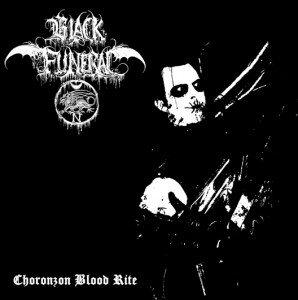 Black Funeral – “Choronzon Blood Rite” MCD
Black Funeral – “Choronzon Blood Rite” MCD
From the storms which tear the earth, haunting the skies at night, empowering chaos and embracing vampyric magick, the cult USBM horde Black Funeral return from the abyss with this morbid spell of blood lust and darkness! Raw, vampyric & occult Black Metal.
Pre-orders “soon” at Dark Adversary.
No CommentsWorm Gear zine returns
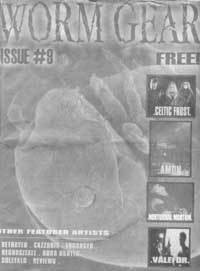 Worm Gear Zine has officially relaunched, with 19 reviews and new interviews with Agalloch and Forefather! We know it has been a long time, but we are excited to have revived this stalwart bastion of extreme music. Expect more frequent updates and more of the quality writing you’ve always depended upon. We welcome all readers to this resurrected endeavor, and are eager to hear your thoughts and to get your participation in our ongoing discussion of the underground. And don’t forget to follow us on Twitter as well!
Worm Gear Zine has officially relaunched, with 19 reviews and new interviews with Agalloch and Forefather! We know it has been a long time, but we are excited to have revived this stalwart bastion of extreme music. Expect more frequent updates and more of the quality writing you’ve always depended upon. We welcome all readers to this resurrected endeavor, and are eager to hear your thoughts and to get your participation in our ongoing discussion of the underground. And don’t forget to follow us on Twitter as well!
From our original review of Worm Gear zine back in 1998:
No CommentsProfessional layout belies the depth to which this magazine sinks into the underground, asking up-front questions in a variety of reviews, features and interviews. Excellent coverage on an individual basis of those bands and individuals lucky enough to be featured in this solid zine from Michigan.
Destroying Texas 7 – Absu, Bahimiron, Inquisition, Blaspherian – Sunday, November 3
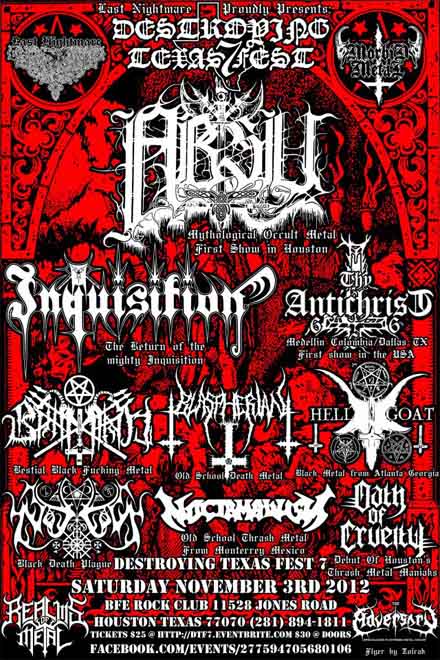 DESTROYING TEXAS FEST 7
DESTROYING TEXAS FEST 7
ABSU
INQUISITION
THY ANTICHRIST
BAHIMIRON
HELLGOAT
BLASPHERIAN
NODENS
OATH OF CRUELTY
NOCTAMBULISM
Saturday November 3rd 2012
BFE Rock Club
11528 Jones Rd
Houston, TX 77070
Admission: $25 pre-sale/$30 at the door
Starts at 6:00PM
Tags: Black Metal, death metal, live, texas
Sabrewulf – Condemned
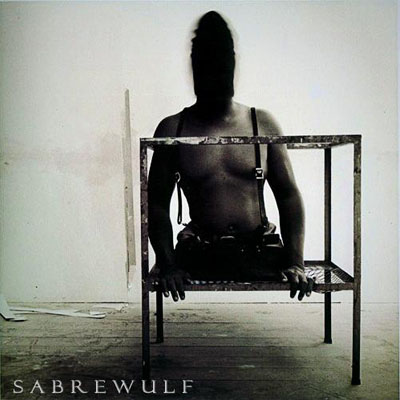
Sabrewulf make doomy music in the new interzone of hybrid between post-punk, metal and drone. These boxy riffs are aggressive and forthright, and hammer home a brainworm of a rhythm and then lapse into drone, as if subjugating the listener with a vision that cannot quite be realized in the present dimension.
No CommentsTags: death metal, sabrewulf
Intolitarian – Berserker Savagery (2012)
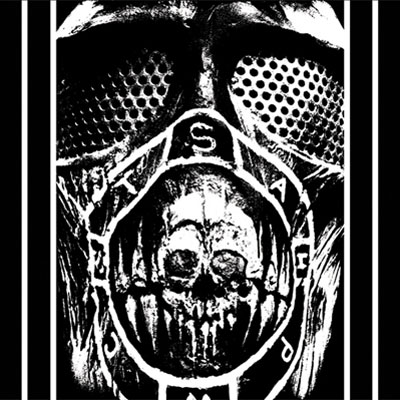 In the intersection between harsh industrial noise and blasting war metal/grindcore, Intolitarian carves a place for itself by being unique in its absolute inferno of abrasive sound. These two tracks contain rasping vocals over abrasive waves of noise that sound like a high-tuned bass played through a storm of distortion, spaced out with loudspeaker spoken word designed to evoke a futuristic totalitarian feeling.
In the intersection between harsh industrial noise and blasting war metal/grindcore, Intolitarian carves a place for itself by being unique in its absolute inferno of abrasive sound. These two tracks contain rasping vocals over abrasive waves of noise that sound like a high-tuned bass played through a storm of distortion, spaced out with loudspeaker spoken word designed to evoke a futuristic totalitarian feeling.
The Orwellian nature of this music takes the listener away from the now with a dramatic surge toward the extreme. Drumming resembles some of the more adventurous drum and bass from the late 1980s, riding a wave of gated grinding power electronic noise while the incessant vocals enunciate like a martial arts competition over the top. It is like a news report from hell, or from a future time when all pretense of humanity and morality has been cast aside.
As an intensely reductive medium, this type of grinding industrial noise has almost no musical elements: it is pure rhythm, pure spoken word, and pure texture, but no harmony or melody. The spoken word portions are produced to sound like either 1940s radio or the off-world propaganda spaceships from Blade Runner, giving it an apocalyptic military urgency. Every syllable throbs with violence.
If war metal were to go in this direction, it would get closer to its own ideal. All meaning is destroyed except conflict and propaganda. This isn’t music; it’s mental conditioning, from that moment during the midnight air raid when the world is shaking with explosions and the ranting of state propaganda from a nearby loudspeaker is the only comforting sound. It encourages survival, to push onward, and a confrontation with nothingness.
- Intolitarian – Weapon Of Revolution (21:10)
- Intolitarian – Death Campaign (23:05)
Intolitarian, Berserker Savagery, S.S.P., $10 (Hell’s Headbangers)
No Comments
